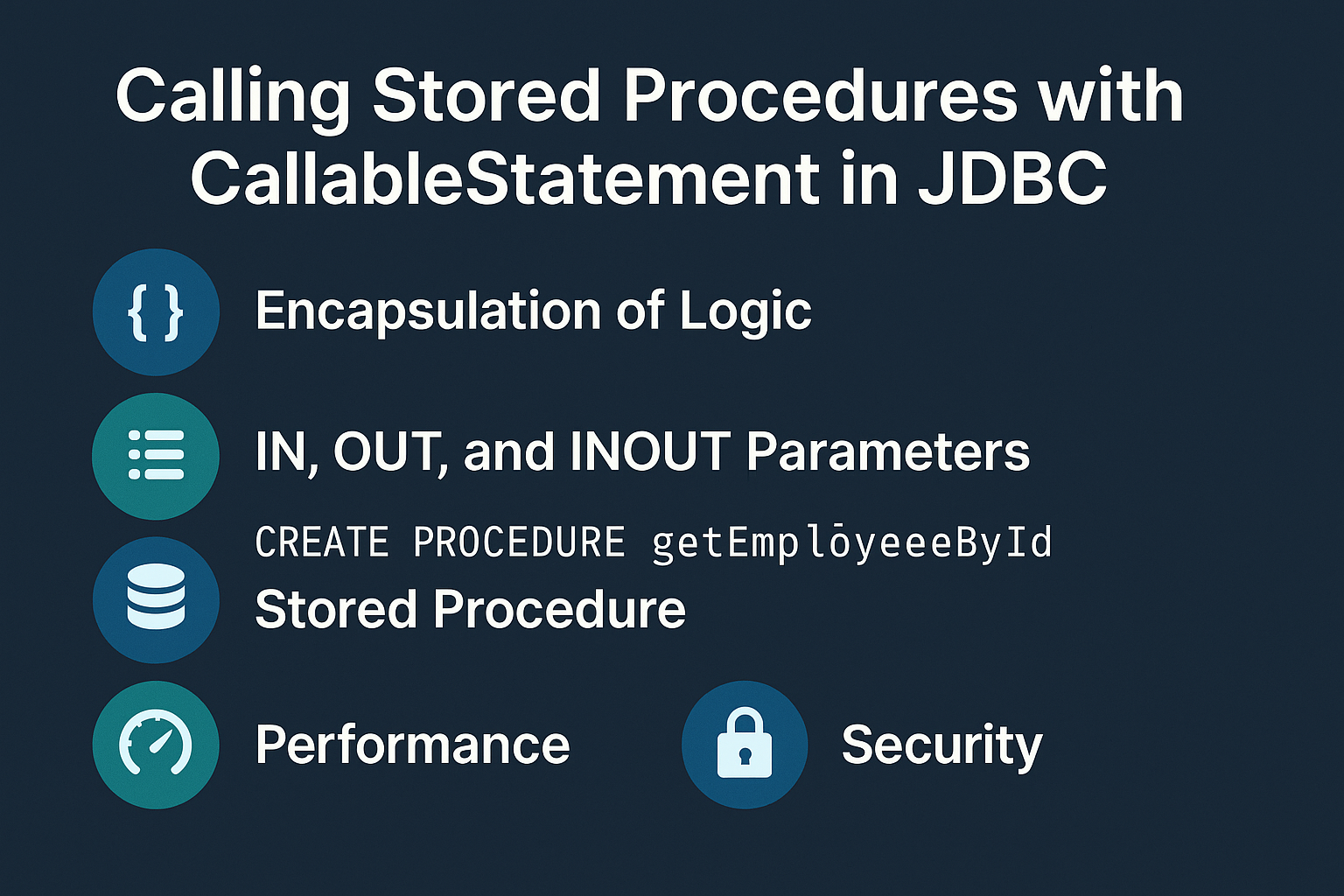Introduction
Stored procedures are precompiled SQL statements stored in the database that encapsulate business logic. JDBC provides the CallableStatement interface to call stored procedures from Java applications.
Why CallableStatement and Stored Procedures Matter
- Encapsulation of Logic: Moves business logic to the database for consistency.
- Performance: Precompiled and optimized by the database engine.
- Security: Controls data access through database permissions.
Core Concepts of CallableStatement
- CallableStatement: Used to execute stored procedures and functions.
- IN Parameters: Input values for the procedure.
- OUT Parameters: Output values returned by the procedure.
- INOUT Parameters: Used for both input and output.
CallableStatement Workflow
Java App → Connection → CallableStatement → Stored Procedure → Database Execution
Real-World Use Cases
- Banking: Executing transaction logic securely on the database side.
- E-commerce: Order processing and inventory updates.
- Data Aggregation: Predefined analytics queries.
- Enterprise Apps: Complex workflows encapsulated in stored procedures.
Creating and Calling a Stored Procedure
Example Stored Procedure (MySQL)
DELIMITER //
CREATE PROCEDURE getEmployeeById(IN empId INT)
BEGIN
SELECT id, name, role FROM employees WHERE id = empId;
END //
DELIMITER ;
Calling the Procedure in Java
import java.sql.*;
public class CallableStatementExample {
public static void main(String[] args) {
String url = "jdbc:mysql://localhost:3306/testdb";
String user = "root";
String password = "password";
try (Connection conn = DriverManager.getConnection(url, user, password);
CallableStatement cs = conn.prepareCall("{CALL getEmployeeById(?)}")) {
cs.setInt(1, 1);
try (ResultSet rs = cs.executeQuery()) {
while (rs.next()) {
System.out.println(rs.getInt("id") + " - " + rs.getString("name"));
}
}
} catch (SQLException e) {
e.printStackTrace();
}
}
}
Handling IN and OUT Parameters
Example Stored Procedure with OUT Parameter (PostgreSQL)
CREATE OR REPLACE FUNCTION getEmployeeCount(OUT count INT)
AS $$
BEGIN
SELECT COUNT(*) INTO count FROM employees;
END;
$$ LANGUAGE plpgsql;
Calling with OUT Parameter in Java
try (CallableStatement cs = conn.prepareCall("{CALL getEmployeeCount(?)}")) {
cs.registerOutParameter(1, Types.INTEGER);
cs.execute();
int count = cs.getInt(1);
System.out.println("Total Employees: " + count);
}
Statement vs PreparedStatement vs CallableStatement
| Feature | Statement | PreparedStatement | CallableStatement |
|---|---|---|---|
| Use Case | Static SQL queries | Parameterized dynamic queries | Calling stored procedures |
| SQL Injection Safety | Vulnerable | Safe | Safe |
| Performance | Re-parsed every time | Precompiled | Precompiled |
Common Mistakes and Anti-Patterns
- Not matching parameter order with stored procedure definition.
- Forgetting to register OUT parameters.
- Using business logic-heavy stored procedures instead of service-layer logic.
- Not handling exceptions and closing resources properly.
Security Implications
- Use least privilege for database accounts calling stored procedures.
- Validate input parameters to prevent unexpected behavior.
- Combine with
PreparedStatementfor queries inside procedures if needed.
Performance and Scalability
- Stored procedures are precompiled, improving performance.
- Use batching when calling procedures in loops.
- Avoid very large, complex procedures that are hard to maintain.
Best Practices
- Use CallableStatement for stored procedures, not normal SQL.
- Always register OUT parameters when needed.
- Use try-with-resources to manage JDBC resources.
- Keep stored procedures focused on data access and simple logic.
Real-World Analogy
Think of a stored procedure as a vending machine. You provide input (coins and selection), and it gives output (product). CallableStatement is the button you press to trigger the machine to work.
Conclusion & Key Takeaways
CallableStatementenables Java apps to call database stored procedures.- Use IN, OUT, and INOUT parameters for flexible procedure design.
- Stored procedures improve performance and encapsulate logic in the database.
FAQ
-
What is CallableStatement in JDBC?
An interface to call stored procedures and functions in the database. -
When to use CallableStatement?
When you need to execute stored procedures from Java applications. -
What are IN and OUT parameters?
IN parameters pass data to the procedure, OUT parameters return data. -
Is CallableStatement secure?
Yes, it uses parameter binding to prevent SQL injection. -
Can CallableStatement return ResultSet?
Yes, for procedures that return query results. -
Does CallableStatement work with all databases?
Yes, supported by all major RDBMS via JDBC. -
How to call functions instead of procedures?
Use{?= call functionName(?)}syntax for functions with return values. -
Can I use transactions with CallableStatement?
Yes, combine with commit/rollback for transactional consistency. -
Is it better to use stored procedures or inline SQL?
Depends on the project; stored procedures centralize logic, inline SQL gives more flexibility. -
Does CallableStatement support batching?
Yes, you can add multiple calls to a batch for performance.
